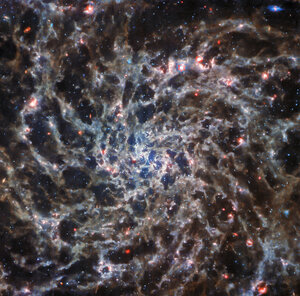

Hubble & Webb: Galaxies IC 2163 and NGC 2207
The gruesome palette of these galaxies is owed to a mix of mid-infrared light from the NASA/ESA/CSA James Webb Space Telescope, and visible and ultraviolet light from the NASA/ESA Hubble Space Telescope. The pair grazed one another millions of years ago. The smaller spiral on the left, catalogued as IC 2163, passed behind NGC 2207, the larger spiral galaxy at right.
Both have increased star formation rates. Combined, they are estimated to form the equivalent of two dozen new stars that are the size of the Sun annually. Our Milky Way galaxy forms the equivalent of two or three new Sun-like stars per year.
Both galaxies have hosted seven known supernovae, each of which may have cleared space in their arms, rearranging gas and dust that later cooled, and allowed many new stars to form. Find these areas by looking for the bluest regions.
[Image description: Two spiral galaxies take up almost the entire view and appear to be overlapping. The galaxy at left, IC 2163, is smaller and more compact than the galaxy at right, NGC 2207. The black background of space is dotted with foreground stars and extremely distant galaxies.]





